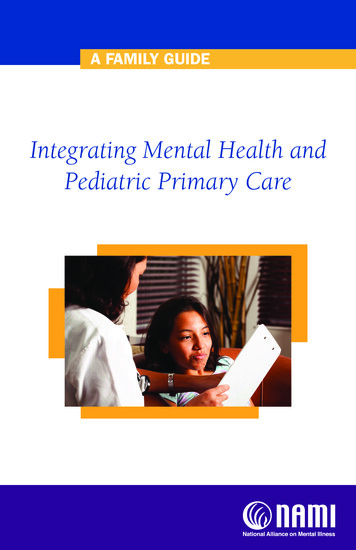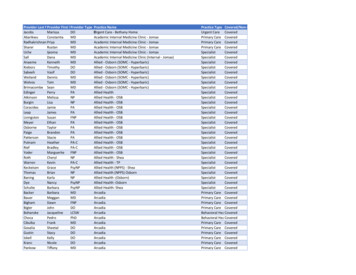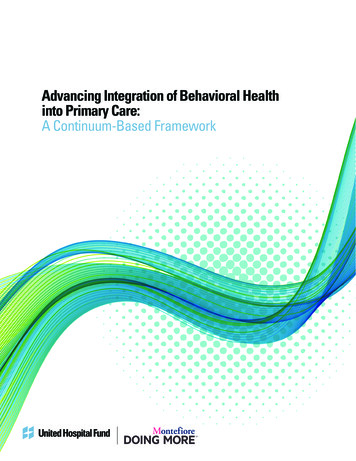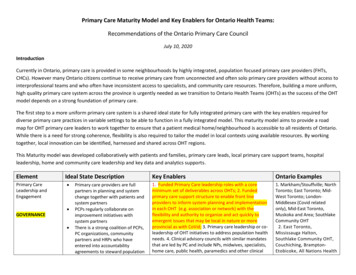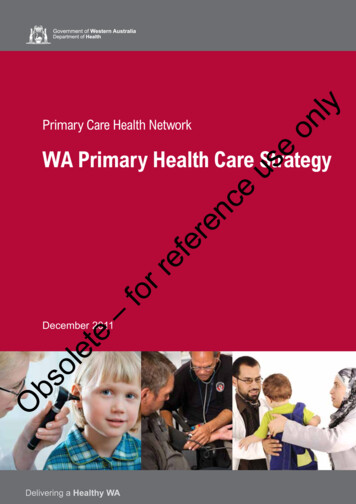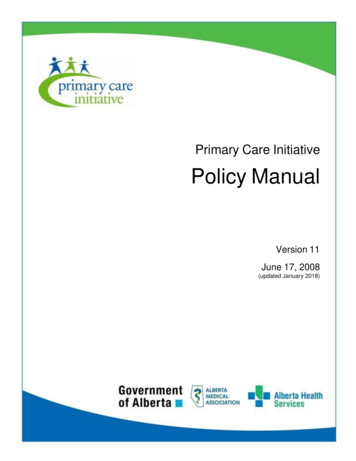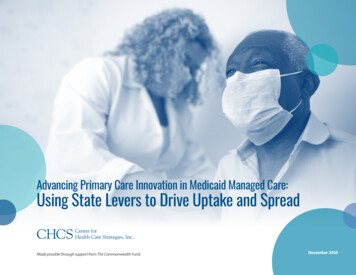
Transcription
Advancing Primary Care Innovation in Medicaid Managed Care: Using State Levers to Drive Uptake and SpreadAdvancing Primary Care Innovation in Medicaid Managed Care:Using State Levers to Drive Uptake and SpreadMade possible through support from The Commonwealth Fund.November 20200
Advancing Primary Care Innovation in Medicaid Managed Care: Using State Levers to Drive Uptake and SpreadContentsI. Introduction . 2Advanced Primary Care Strategies in the Context of COVID-19 . 3Medicaid Managed Care’s Unique Role in Advancing Primary Care Innovation. 4II. Strategies to Drive Uptake and Spread of Advanced Primary Care . 51. Promote Accountability Mechanisms for Managed Care Organizations . 72. Move to Value-Based Payment in Primary Care . 153. Monitor Primary Care Spending and Investment . 29III. Conclusion .37AuthorsKelsey Brykman, Diana Crumley, and Rachael Matulis*Center for Health Care StrategiesAcknowledgementsThe authors would like to express theirappreciation to David Labby, MD, PhD, healthstrategy advisor at Health Share of Oregon, forhis insights and feedback in the developmentof this toolkit. The authors would also like tothank Tricia McGinnis, executive vice presidentand chief program officer, at Center for HealthCare Strategies, for lending her subject matterexpertise and guidance throughout thisprocess.About the Center for Health CareStrategiesThe Center for Health Care Strategies (CHCS)is a nonprofit policy center dedicated toimproving the health of low-incomeAmericans. It works with state and federalagencies, health plans, providers, andcommunity-based organizations to developinnovative programs that better servebeneficiaries of publicly financed care,especially those with complex, high-costneeds. To learn more, visit www.chcs.org.*Rachel Matulis is a former associate director at CHCS.1
Advancing Primary Care Innovation in Medicaid Managed Care: Using State Levers to Drive Uptake and SpreadI. IntroductionPrimary care is a central component of a high-functioning health system andparticularly important for enhancing health care access and quality for vulnerablepopulations.1,2,3,4 The U.S., however, underinvests in primary care5,6 and the feefor-service payment system is frequently cited as a barrier to implementation ofinnovative, patient-centered care delivery models.7,8 Medicaid programs can play a keyrole in building a more robust primary care system, particularly given the health systemchallenges and pre-existing health disparities compounded by the COVID-19 pandemic. 9Advancing Primary Care Innovation in Medicaid Managed Care: A Toolkit for States isdesigned to help states leverage their managed care purchasing authority to advance primarycare innovation. The first section of this toolkit, Conceptualizing and Designing CoreFunctions, explores considerations for how states can define primary care priorities and advancetargeted primary care delivery goals. This second section of the toolkit, Using State Levers toDrive Uptake and Spread, outlines how states can incentivize and invest in advanced primary carethrough Medicaid managed care and consists of three modules:1. Promote accountability mechanisms for managedcare organizations2. Move to value-based payment in primary care3. Monitor primary care spending and investmentThe strategies outlined here can be mutually reinforcing for providers and managed care organizations (MCOs). Directing moreoverall spending toward primary care can enable innovations incentivized at the MCO and provider levels. Similar to the firstsection of the toolkit, each module in this section outlines design considerations for Medicaid agencies, provides state examples,and highlights sample managed care contract language.2
Advancing Primary Care Innovation in Medicaid Managed Care: Using State Levers to Drive Uptake and SpreadAdvanced Primary Care Strategies in the Context of COVID-19Prior to the COVID-19 pandemic, there was a strong case that the U.S. primary care system neededto be strengthened. Primary care is associated with better health outcomes, reduced mortality,lower costs, and decreased hospital and emergency department visits. 10,11,12,13 Research furthersuggests that primary care access helps reduce socioeconomic disparities in health.14,15 Despitethis, the U.S. has historically spent a far smaller proportion of health care expenditures on primarycare compared to peer countries. 16 Between 2008 and 2016, the U.S. has seen a decline in primarycare visits 17,18 and primary care workforce shortages are projected to grow. 19,20Advancing Primary Care Innovation inMedicaid Managed Care: Conceptualizingand Designing Core FunctionsToday, COVID-19 is compounding challenges in health care access and quality for vulnerablepopulations and further highlighting the need for a robust primary care system. Furthermore,primary care practices are under significant financial strain due to reduced visits, especially early inthe pandemic. And while overall primary care visits rebounded as of October 2020, variation acrossproviders remain 21 and COVID-19 surges may pose continued challenges. Many practices haveexperienced layoffs and furloughed staff and remain uncertain about ongoing financial viability. 22Primary care staff are also stretched thin, due to factors such as working unpaid hours andmental/emotional exhaustion. 23At the same time, the COVID-19 pandemic has made the need for a high-quality primary caresystem even more critical. Primary care plays an important role in ongoing COVID-19 surveillancethrough means such as triaging symptomatic patients, coordinating testing, and managing care ofat-risk patients and patients with mild symptoms. 24 Primary care is also well positioned to helpcoordinate and respond to the behavioral health and social service needs resulting from thepandemic. 25, 26 COVID-19’s disproportionate impact on people of color and low-incomecommunities, 27, 28 further underscores the need for more equitable access to high-quality primarycare services.This confluence of factors puts primary care at a crossroad: at a time when financialchallenges and staff burnout threatens sustainability of the primary care system, thepandemic has also opened a path for rapid care delivery transformation. Many primary carepractices have responded to COVID-19 by adopting innovations to meet the needs of the moment.For example, in face of a decline in in-person visits, telehealth has been rapidly adopted. Accordingto one study of outpatient visits across a range of specialties, telehealth made up only 0.1 percentof visits in February 2019, peaked at 13.8 percent of visits in April 2020, and made up 6.3 percent ofvisits at the beginning of October 2020. 29 Primary care providers are also innovating in other waysin response to the pandemic, including accelerating adoption of or implementing new caremanagement and population health models.30,31 Going forward, there is an opportunity forUsing State Levers to Drive Uptake and Spread is the secondsection in a two-part toolkit. The first section of the toolkit,Conceptualizing and Designing Core Functions, exploresconsiderations for how states can define primary care prioritiesand advance targeted primary care delivery goals to: Address social needs; Integrate behavioral health into primary care; Enhance team-based primary care approaches; and Use technology to improve access to care.The managed care levers of accountability mechanisms, valuebased payment, and primary care investment outlined herecan be used to advance any of the above primary care goals.Learn more at: www.chcs.org/primary-care-innovation.3
Advancing Primary Care Innovation in Medicaid Managed Care: Using State Levers to Drive Uptake and Spreadadoption of new models of team-based care and deepened cross-sector partnerships, such as between primary care and socialservice providers and public health agencies.32,33, 34Medicaid Managed Care’s Unique Role in Advancing Primary Care InnovationState Medicaid programs collectively cover over 70 million people in the U.S., enabling these programs to play a key role in bothstabilizing primary care in the near-term, as well as supporting a transformed and more robust primary care system in the longterm. Moreover, Medicaid support is critical given its relationship with safety net providers and coverage of populations that aredisproportionately impacted by COVID-19, including people of color and individuals with low-income. 35Using State Levers to Drive Uptake and Spread — the second section of Advancing Primary Care Innovation in MedicaidManaged Care: A Toolkit for States — is designed to guide states in this role by describing how Medicaid agencies can leveragetheir managed care programs and contracts to invest in and pay providers for advanced primary care. The toolkit is a product ofAdvancing Primary Care Innovation in Medicaid Managed Care, a national initiative made possible by The CommonwealthFund and led by the Center for Health Care Strategies (CHCS). Through the initiative, CHCS assisted 10 states — Delaware,Hawaii, Louisiana, Nevada, Pennsylvania, Rhode Island, Tennessee, Texas, Virginia, and Washington State — in using theirmanaged care purchasing authority to advance innovations in primary care. This second section of the toolkit summarizesstrategies used by these states and others to invest in and pay for more comprehensive, coordinated, and patient-centeredprimary care services.4
Advancing Primary Care Innovation in Medicaid Managed Care: Using State Levers to Drive Uptake and SpreadII. Strategies to Drive Uptake and Spread ofAdvanced Primary CareWhile there are a number of managed care levers that states may consider to advanceprimary care priorities (see Exhibit 1 on the next page), this section of AdvancingPrimary Care Innovation in Medicaid Managed Care: A Toolkit for Statesspecifically focuses on strategies that impact primary care investment and MCO and primarycare practice payment. It includes three modules:1. Promote Accountability Mechanisms for Managed Care Organizations outlinesoptions for incentivizing Medicaid MCOs to work toward states’ defined goals forinvesting in primary care. Specifically, it describes options for tying MCO payment tocontract requirements or quality performance and directing MCO spending. Thismodule also explores how states can provide guidance on classification of MCOexpenditures, which can further encourage MCOs to invest in activities that supportenrollees’ health-related social needs.2. Move to Value-Based Payment in Primary Care describes how states can leverage managedcare programs to advance value-based payment (VBP) models for primary care providers thatreward value instead of volume of services. VBP models can support primary care goals byallowing practices more flexibility to implement services that may not be covered under traditionalfee-for-service payment. States can also advance specific care delivery goals by tying payment torelevant quality measures or requiring certain care delivery capabilities for participation in VBP models.3. Monitor Primary Care Spending and Investment explores how states can track primary care spend and increasethe portion of health spending devoted to primary care. Such policies can be an important foundation for ensuringproviders receive sufficient funding to develop and sustain advanced primary care capabilities.Used together, these strategies can be mutually reinforcing by directing more total spending toward primary care, while alsocreating incentives at both the MCO and provider levels to advance primary care. Each of the modules in this toolkit outlinedesign considerations for Medicaid agencies, share state examples, and highlight sample managed care contract or request forproposal (RFP) language. This section of the toolkit also includes considerations for how states may adapt managed care leversas part of a broader Medicaid COVID-19 response and to support providers through the pandemic.5
Advancing Primary Care Innovation in Medicaid Managed Care: Using State Levers to Drive Uptake and SpreadExhibit 1. Opportunities within Managed Care to Advance Primary Care InnovationMany traditional MCO functions can be used to advance primary care innovation. The modules here focus on MCO payment andVBP strategies.Care Coordination/Management Partnerships withprimary care teams,including data sharingPopulation healthmanagementScreening for socialand behavioral healthneeds, in coordinationwith primary careteams and otherprovidersMCOPayment MCO incentives tied toperformance onprimary care qualitymeasures orcontractualrequirementsClarification on howMCO expendituresmay be classified Focus of this toolkitQualityAssessment andPerformanceImprovementProviderNetworkRequiring providertraining and incentivesrelated to PCIAdvancing certainmodels of care andprimary care screeningTime/distancestandards for primarycare providersNetwork makeup (e.g.,inclusion of PCMHs,ACOs, etc.) Performanceimprovement projectsthat: advance certainmodels of care (e.g.,advanced PCMHmodels); integratebehavioral health; oradvance strategies toaddress social needsUtilizationManagementServices Carving in a widerscope of services(e.g., integration ofbehavioral andphysical health)Clarifying flexibility toprovide value-addedand in-lieu of servicesthat may addresssocial or behavioralhealth needs Clarification onappropriate andinappropriateutilization management practices relatingto telemedicine ormodels that integratebehavioral andphysical healthservicesValue-BasedPayment Requiring plans tointegrate PCI-relatedstrategies into VBPinitiatives for providers(e.g., models thatsupport addressingsocial needs)Alignment with nonMedicaid models(e.g., Primary CareFirst) or adoption ofstate models (e.g.,Medicaid ACOs)Focus of this toolkit6
Advancing Primary Care Innovation in Medicaid Managed Care: Using State Levers to Drive Uptake and Spread1. Promote Accountability Mechanisms forManaged Care OrganizationsPROMOTE ACCOUNTABILITY MECHANISMS FOR MCOS:States have a variety of tools that can encourage, incent, or requireMCOs to work toward the state’s defined goals for primary careinnovation, such as:States seeking to further financially incentivize MCOs toinvest in and support advanced primary care may consider: Incentive arrangement;Rate adjustment;Design Considerations SummaryPlanning What are the state’s budgetary constraints? How prescriptive does the state wish to be in its approach? How strong does the state want MCO incentives to be? State-directed payments;Community investment; andIs the state prepared to enlist actuaries or other specialized staff to support thedevelopment of these mechanisms? Strategic classification of MCO expenditures.Implementation Withhold arrangement;Liquidated damages and penalties;Auto-assignment;Broadly, these tools seek to: (1) direct targeted MCO efforts;(2) ensure that MCOs have the financial and administrativeflexibility to creatively support network providers and members;and (3) reward MCOs for their performance. This module providesa broad overview of these financial accountability mechanismsand highlights how they can be used to drive investments inprimary care. It also highlights ways that states have releasedfunds associated with these tools, such as withholdarrangements to enable quick support of network providersduring the COVID-19 pandemic. Will the state require MCOs to report on how they will distribute funds relating towithhold or incentive arrangements to support network providers and communitybased strategies? Will the state offer alternatives to penalties and remittances to encourage additionalinvestments in communities and network providers? If plans provide additional services to members and support advanced primary carecapabilities, do plans know how to report associated expenses, as it relates to themedical loss ratio or rate-setting? Can the state improve guidance to the plans oradjust rates to counteract disincentives?Planning Considerations What are the state’s budgetary constraints?Certain managed care accountability mechanisms require more funds than others. Incentive arrangements, for example,can result in payment over and above a Medicaid MCO’s capitation payment — capped at five percent of the capitationpayment, per federal rules. 36 Other state initiatives may be funded by a corresponding rate adjustment, and may be closelymonitored via contract requirements. For example, Pennsylvania’s community-based care management program is fundedby a per-member-per-month rate and corresponding rate adjustment, and MCOs must submit plans that explain how they7
Advancing Primary Care Innovation in Medicaid Managed Care: Using State Levers to Drive Uptake and Spreadwill spend those funds to support strategies relating to program goals, such as team-based care and social determinants ofhealth.37,38 States considering these options must have the budgetary flexibility to implement them.Other approaches — such as withhold arrangements tied to quality performance and liquidated damages, requiring MCOsto return funds to the state if certain conditions are not met — do not require additional funds.Defining State Primary Care GoalsThe MCO accountability mechanisms described in this module can be used to support a wide range ofstate primary care goals. Prior to exploring specific accountability mechanisms to include in MCOcontracts, states may consider identifying specific primary care transformation priorities. For example,states may leverage these accountability mechanisms to advance primary care delivery goals such as:(1) enhancing team-based care; (2) integrating behavioral health into primary care; (3) using technology toimprove access to care; and (4) identifying and addressing social needs.Additional considerations for identifying primary care priorities and advancing these specific care delivery components areavailable in the first section of this toolkit, Conceptualizing and Designing Core Functions. How prescriptive does the state wish to be in its approach?Some managed care accountability mechanisms generally allow MCOs more flexibility in implementing a primary carestrategy while others are more prescriptive. Flexible approaches can allow innovation and MCOs to adapt primary carestrategies to specific regional or provider needs. Prescriptive approaches can be useful in cases where states seek toimplement consistent primary care strategies across payers. For example, withhold arrangements tied to VBPimplementation often allow MCOs and providers a great deal of flexibility in designing and negotiating VBP arrangements.Alternatively, subject to Centers for Medicare & Medicaid Services (CMS) approval, states can require MCOs to pay primarycare providers a certain way, such has through specific, state-designed VBP models. 39 How strong does the state want MCO incentives to be?While strong incentives draw more attention to and can potentially allow states to achieve policy goals faster, they also havegreater risk of unintended consequences. States may consider factors such as strength of the evidence-base andpayer/provider experience with a given approach when determining what level and type of incentive is appropriate.8
Advancing Primary Care Innovation in Medicaid Managed Care: Using State Levers to Drive Uptake and SpreadStrategies directly tied to MCO payment, such as rate adjustments or withhold arrangements may be stronger incentivesthan those indirectly tied to payment, such as quality-based auto-assignment. Some accountability mechanisms, such aswithholds and penalties or liquidated damages, also allow states flexibility in determining/adjusting the level of financialincentive. Is the state prepared to enlist actuaries or other specialized staff to support the development ofthese mechanisms?Certain approaches may require more thoughtful review by actuarial, financial, or legal staff. When states implement awithhold arrangement, for example, an actuary must determine that the “capitation payment minus any portion of thewithhold that is not reasonably achievable is actuarially sound.” 40 Similarly, states that use liquidated damages in theirMedicaid managed care contracts ideally should structure those as “reasonable estimates” of an agency’s loss or damage,41which may require more careful review by financial or legal staff.Examples of States’ Primary Care-Related COVID-19 Response EffortsNew Hampshire reallocated 1.5 percent of capitation dollars to fund provider rate enhancements inthe form of managed care directed payments. The goal was to redirect funds to providers who are moststressed from reduced utilization amid the pandemic. Funding was distributed to the followingprovider types for the rating period covering September 1, 2019 through June 30, 2020 through a uniformpercent increase: critical access hospitals, residential substance use disorder providers, home health careproviders, private duty nursing providers, personal care providers, and federally qualified health centers andrural health centers. 42,43Oregon released 60 percent of the 2019 Quality Pool Fund earlier than planned (in March 2020) “to support the needs acrossOregon to prepare for the surge in patients needing care, maintain capacity, and ensure access to care across the deliverysystem.” The state also suspended the 2020 Quality Withhold during the COVID-19 emergency. 44For more information on how states can modify their withhold arrangements, incentive arrangements, and penalties inresponse to the COVID-19 pandemic, see COVID-19 Frequently Asked Questions (FAQs) for State Medicaid and Children’sHealth Insurance Program (CHIP) Agencies. 459
Advancing Primary Care Innovation in Medicaid Managed Care: Using State Levers to Drive Uptake and SpreadState Approaches: Accountability MechanismsBelow is an overview of the different accountability mechanisms available to states, with specific examples relevant to primarycare and core care delivery areas.Summary of StrategyRelevant State ExamplesApproaches that May Require Additional State FundsIncentive Arrangement. Implement anincentive payment program that providesMCOs with additional funds over and abovethe capitation payment for performance onselected quality measures or activities thatrelate to advanced primary care. Totalpayment may not exceed 105% of thecapitation payment.Arizona, under its Quality Measure Performance Incentive Program, enables MCOs to receive additional funds for performance onselect quality measures related to primary care utilization, such as well-child, well-care, and annual dental visits. 46Rate Adjustment. Direct MCOs toparticipate in a targeted initiative and embedadditional funding into the monthlycapitation payment. Alternatively, changethe way rates are structured to rewardstrategic investments and programs,efficiency, and quality.Pennsylvania makes per-member-per-month payments for MCOs’ community-based care management (CBCM) programs as part ofthe monthly capitation process. Physical health MCOs submit a plan for their program, which can support face-to-face carecoordination activities by primary care providers and strategies to address health-related social needs. 48 For example, CBCM hassupported co-location opportunities at federally qualified health centers and through community health workers. 49New York groups MCOs into five tiers based on performance on 41 measures, plus a bonus for telehealth innovation, and uses resultsto inform incentive payments and auto-assignment preference. 47New Mexico requires MCOs to pay for their share of administrative expenses for Project ECHO, a telementoring program designed toprovide primary care providers with knowledge and support to manage patients with complex conditions. The state appropriated 850,000 to support this initiative, which is distributed to MCOs via capitation payments.In its new “Performance Based Reward Program,” Oregon will reward plans with an increase in the non-medical load portion of rate,based on spending on voluntary services that can improve health care quality (i.e., “health-related services”) and efficiency and qualitymetrics. 50Approaches that Do Not Require Additional State FundsWithhold Arrangement. Withhold apercentage of MCOs’ monthly capitationpayment. MCOs can gain or lose the entireamount withheld based on performance. Useto incentivize adoption of a wide range ofactivities that could impact adoption ofadvanced primary care: primary-care focusedVBP, quality measures, and patient-centeredmedical home (PCMH) adoption.Michigan, as part of its withhold arrangement, encourages its plans to implement targeted programs aimed at improving healthoutcomes, such as implementation of an evidence-based, integrated model that addresses low-birth weight through management ofmedical and social needs. 51Prior to 2020, Patient-Centered Primary Care Home program enrollment was one of Oregon’s 19 coordinated care organization (CCO)quality measures used to determine reward payments out of “quality pool” funds. The quality pool is funded through a withhold and isat least two percent of aggregate CCO payments made to all CCOs. 52,53Washington State ties a portion of its two percent capitation payment withhold to VBP thresholds and distributes “challenge pool”funds based on VBP achievement. For example, for 2020, Washington State requires that 85 percent of MCO health care payments toproviders are within qualifying VBP arrangements, defined as level 2C (pay-for-performance) or higher on the Health Care PaymentLearning & Action Network Alternative Payment Model Framework. 54In addition to general VBP targets, states could also consider tying withholds to primary care-specific VBP models or prioritizingprimary care VBP models as part of general VBP requirements.10
Advancing Primary Care Innovation in Medicaid Managed Care: Using State Levers to Drive Uptake and SpreadSummary of StrategyRelevant State ExamplesLiquidated Damages and Penalties.Require MCOs that do not meet a certainprimary-care related standard to return fundsto the state.55Tennessee notes in its contract that “failure to achieve benchmarks of 37 percent PCMH membership” results in a damage of “ 500 percalendar day.” 56New Mexico ties performance on a series of “delivery system improvement performance targets” to a penalty of 1.5 percent ofcapitation payments. For example, achievement of each of the following targets is assigned 25 out of 100 possible points related to thepenalty: 57“The contractor shall increase the number of unduplicated Medicaid Managed Care members receiving Behavioral Health servicesby a Non-Behavioral Health provider.”“The contractor shall increase the number of unique Members with a Telemedicine visit by twenty percent (20%) in Rural, Frontier,and Urban areas for Physical Health Specialists and Behavioral Health Specialists.”Auto-Assignment. Award membership toplans based on primary care-relatedcapabilities and/or performance, or otherrelated state priorities (e.g., communityinvestment), given that MCOs are oftenmotivated by increasing their market share.Ohio bases auto-assignment on three factors, including performance on women’s health measures; primary care provider (PCP) anddental capacity; and prompt payment. 58In addition to primary-care-related quality measures, California’s auto-assignment methodology includes the following “safety netmeasure:” “percentage of members assigned to PCPs who are safety net providers (based on rates provided by the MCPs that havebeen validated by DHCS and validation of a sample of screen prints verifying PCP assignments).’Safety net providers’ are defined as:FQHCs, Rural Health Centers, Indian or Tribal Clinics, non-profit community or free clinics licensed by the state as primary care clinics, orclinics affiliated with DSH facilities.” 59North Carolina may award an auto-assignment preference to PHPs that voluntarily contribute at least 0.1 percent of capitation tohealth-related resources in the region. 60State-Directed Payments. Require MCOs topay PCPs in a certain way (i.e., to implement aVBP model or to participate in a multi-payeror Medicaid-specific delivery system reformor performance improvement initiative).61Tennessee’s Health Link program, which aims to enhance coordination between behavioral and physical health services for TennCaremembers with high behavioral health needs, is implemented through state-directed payment. Participating providers are eligible toreceive practice transformation support, new activity payments, and outcome payments based on performance of quality andefficiency metrics. 62Community Reinvestment. Require MCOsto spend a portion of profits or reserves onlocal communities, including health-relatedsocial needs.Arizona requires MCOs to contribute six percent of annual profits to community reinvestment. (See related reporting template.) 63State Medicaid agencies have submitted statements of interest relating to the Primary Care First model. If states elect to align payment,quality measurement, and data sharing with CMS in support of Primary Care First practices, states can direct MCOs to adopt thesestandards via a contract amendment and CMS approval.Oregon, as part of its Supporting Health for All through Reinvestment Initiative (SHARE), wil
populations and further highlighting the need for a robust primary care system. Furthermore , primary care practices are under significant financial strain due to reduced visits, especially early in the pandemic . And while overall primary care visits rebounded as of October 2020, variation across providers remain
